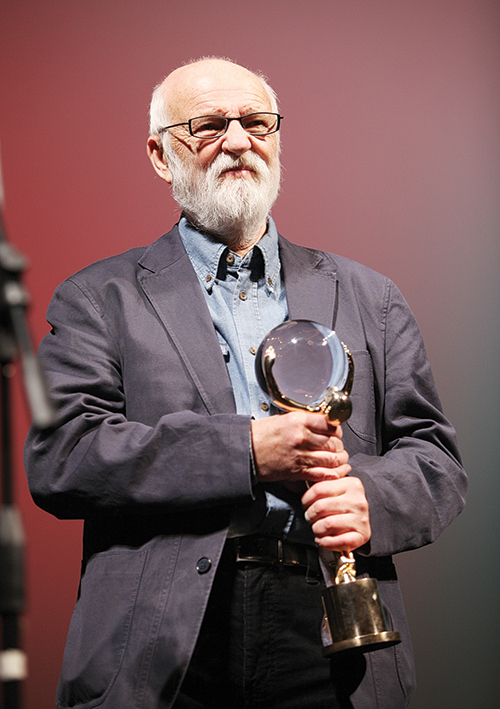“Today, art is all but dead anyway,” according to Czech filmmaker Jan Svankmajer, the
godfather of stop-motion animation who popularized claymation. The Portland Art Museum’s Northwest Film Center is presenting a retrospective of Svankmajer’s influential career that
continues to run this weekend at the center’s Whitsell Auditorium.
King of claymation

“Today, art is all but dead anyway,” according to Czech filmmaker Jan Svankmajer, the godfather of stop-motion animation who popularized claymation. The Portland Art Museum’s Northwest Film Center is presenting a retrospective of Svankmajer’s influential career that continues to run this weekend at the center’s Whitsell Auditorium.
With nearly 50 years of filmmaking under his belt, Jan Svankmajer has influenced Hollywood bigwigs such as Tim Burton (The Nightmare Before Christmas) and Terry Gilliam (Brazil). Undoubtedly, he would outwit, out-gross and out-macabre both of them.
The center’s retrospective, titled “Jan Svankmajer: Conspirator of Pleasure” (the name is derived from his film Conspirators of Pleasure), features screenings of one collection of Svankmajer’s short films, three feature-length films and a feature-length vignette.
“The NWFC has chosen to showcase Svankmajer’s work several times in the past,” said Jessica Lyness, the center’s marketing manager, in an email. “For this series, we had help from the Czech Center in New York and Irena Kovarova.”
Svankmajer’s hyper-stylized films achieve surrealism by dissecting reality until the the vile yet innate nature of human experience is exposed like bone beneath flesh. No wonder he so often uses meat (Lunacy) and skeletal remains (Alice) to convey his visionary ethos. Every bit of every frame is deliberate and loaded with meaning.
“Often I hear animators rattle him off as one of their inspirations and I expect in Portland, with our robust community of filmmakers and animators, that we’ll have great crowds for this show,” Lyness said. “For cinephiles and film students his craftsmanship and story-telling are legendary.”
Time does not exist linearly in any of his films; instead, time is explored in every direction. The past, present and future are difficult to distinguish, and no particular historical periods are referenced through the films’ costumes and settings.
This relinquishment of time is especially prevalent in his films Faust and Lunacy: Characters ride in archaic carriages on a freeway with semitrucks (Lunacy) or perform antiquated plays in the secret passageway of a 20th-century Eastern European pub (Faust).
Svankmajer’s sardonic sense of humor blurs the line between good and evil. The master raconteur has a talent for mutilating both until they’re violently juxtaposed, finalizing them in an indiscernible union.
Likewise, the antagonist of most Svankmajer films eventually becomes the victim, until all roles are unrecognizable through a moral lens. Interestingly, the union of opposites was something author Johann Wolfgang von Goethe focused heavily on in his original Faust.
By mocking human desperation, Svankmajer unveils the innately grotesque aspects of life as a spectacle to be analyzed, marveled and scoffed at. Such philosophical depth seems apparent in all of his films, but most so in Little Otik.
“Little Otik is one of my favorite features,” Lyness said.
Drawing inspiration from historical tales by Lewis Carroll, Edgar Allan Poe, Goethe, Franz Kafka, the Marquis de Sade and Czech folk tales, Svankmajer is a master storyteller.
Conspirators of Pleasure
Saturday, Jan. 26, 5 p.m./Sunday, Jan. 27, 7 p.m.
Svankmajer Shorts
Tuesday, Jan. 29, 7 p.m./ Friday, Feb. 1, 9 p.m.
Surviving Life
Sunday, Feb. 3, 4:30 p.m./Monday, Feb. 4, 7 p.m.
Nothwest Film Center, Whitsell Auditorium
1219 SW Park Ave.
$9 general, $8 students
His films deliberately reflect the core of every aforementioned literary figure, refine the best of all and distill them into the mythological alchemical gold that is his oeuvre.
Svankmajer uniquely combines stop-motion animation, live action, claymation and puppetry in his movies. His knack for special effects, animation and cinematography will surpass time.
Sadly, the center’s run of Alice, one of the filmmaker’s finest films, is already over.
“Alice had a good turnout,” Lyness said. “Lots of students attended, so maybe a whole new group of people are working away in their basements tonight trying to recreate animated puppets like Svankmajer did in his Lewis Carrol reimagining.”
Must-sees
If you cannot catch the rest of Svankmajer’s catalogue, at least check out these three devilish gems.
Faust – Sunday, Jan. 27, 5 p.m.
Heaven and hell are tearing apart an innocuous man cajoled into entering a full theater-set designed for Dr. Faustus. He is catapulted into a haunting puppet show where the occult worlds of angels and demons are manifested onscreen via claymation and live action.
Mephistopheles is hell bent on tempting the man playing Dr. Faustus away from redemption, and the man finds himself lost in a labyrinth of strange places unfettered by time’s restraints. In the end, he finds all options are futile.
Little Otik – Friday, Feb. 1, 7 p.m.
Fantasy and reality smash together in the lives of a delusional couple plagued by sterility. Like most of his films, the opening scene confuses and disturbs by showing a baby weighed, wrapped in newspaper and then sold to a woman as if it were a choice cut of meat.
Eventually the couple makes their own child by Svankmajer’s typically bizarre, occult-influenced storytelling and stop-motion claymation genius. If bringing a portion of tree trunk to life isn’t a metaphor for fertility, what in the world is?
Lunacy – Saturday, Feb. 23, 2 p.m./Sunday, Feb. 24, 7 p.m.
A Satanic marquis invites a mentally fragile man, Jean, into his home. When Jean discovers the marquis’ true malevolent nature, he cannot bring himself to flee.
Instead, he finds himself locked inside his worst nightmare—an asylum—without solace. However, the patients are not the victims any longer.
(A friendly warning: Beware of explicit scenes and extreme blasphemy in Lunacy!)





